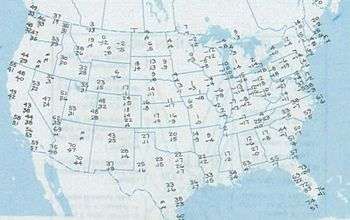Winter 1985 cold wave

The Winter 1985 cold wave[1] was a meteorological event, the result of the shifting of the polar vortex further south than is normally seen.[1] Blocked from its normal movement, polar air from the north pushed into nearly every section of the central and eastern half of the United States and Canada, shattering record lows in a number of areas.[1] The event was preceded by unusually warm weather in the eastern U.S. in December 1984, suggesting that there was a build-up of cold air that was suddenly released from the Arctic, a meteorological event known as a Mobile Polar High, a weather process identified by Professor Marcel Leroux.[2]
Meteorological synopsis
From Sunday, January 20, to Tuesday, January 22, 1985, the polar vortex, coupled with a large ridge of high pressure, moved polar air into the United States as far south as Arizona, Texas, and northern Florida.[1] Unlike most cold air systems, a pattern of self-modification did not immediately occur, i.e. seasonable temperatures were absent for a number of days, a rarity in forecasting.[1]
The Arctic air mass started moving into the United States on the evening of January 19 and the morning of January 20. In Chicago, a record low of −27 °F (−33 °C), combined with 25 miles per hour (40 km/h) winds to produce a wind chill of −60 °F (−51 °C). [3] St. Louis saw a low of −18 °F (−28 °C) and Pittsburgh had a low of −18 °F (−28 °C), the coldest morning since 1899.[4] In Cincinnati, the morning temperature of −21 °F (−29 °C) tied for the fourth-lowest minimum temperature in the city's history, outdone by a cold mass the year before and a blizzard in 1977.[5] Cleveland fell to −18 °F (−28 °C), which was at the time a record.[6] Memphis recorded a low of −4 °F (−20 °C), setting a record low for that day. The coldest temperature in the contiguous states on Jan. 21 was −24 °F (−31 °C), in the unlikely locations of Akron, Ohio[7] and Knoxville, Tennessee.
As the cold air mass moved southeastward it only modified slightly, resulting in frigid air for most of the middle and upper Eastern Seaboard starting on the morning of January 21. New York City's Central Park recorded a low of −2 °F (−19 °C), breaking that date's record.[8] Washington National Airport set a record of −4 °F (−20 °C) for the morning of January 21 and a record low for the prior date of −2 °F (−19 °C).[9] Further south, Roanoke, Virginia set a record low of −11 °F (−24 °C), and the campus of the University of Tennessee at Knoxville, Tennessee, recorded a record low of −24 °F (−31 °C).[1] Tennessee's state capital, Nashville, dropped to −17 °F (−27 °C), while all-time records were set well into interior sections of the deep South, such as −5 °F (−21 °C) in Charlotte,[1] −6 °F (−21 °C) in Macon, Georgia,[1] 7 °F (−14 °C) in Jacksonville, Florida,[1] and 10 °F (−12 °C) in Gainesville, Florida[10] (coldest since 6 °F (−14 °C) in 1899). Atlanta saw a low of −8 °F (−22 °C), setting a record for the month of January and for the 20th century, missing by just one degree the all-time record (since 1879) set in February 1899.[11] Miami, whose average low in late January is 59 °F (15 °C), recorded a record low of 37 °F (3 °C) on the 21st and 34 °F (1 °C) on the 22nd, both record lows for the date. [12][13]
Ferocious cold in February 1985 set two more state record lows in the Mountain West. Utah's −69 °F (−56 °C) was the second-coldest temperature ever recorded in the "lower 48" states, just above Montana's record of −70 °F (−57 °C) in 1954. Colorado's −61 °F (−52 °C) broke the old record of −60 °F (−51 °C), also on February 1.
Impact and aftermath
The cold wave brought human fatalities, deaths of wild and domesticated animals, crop losses, and infrastructure damage to homes, municipality and industrial sites. At least 126 deaths were blamed on the cold snap.[14] Some 90 percent of the citrus crop in Florida was destroyed in what the state called the "Freeze of the Century."[15] Florida's citrus industry suffered $1.2 billion in losses ($2.68 billion in 2016 dollars) as a result of the inclement weather. [16] The public inauguration of President Ronald Reagan for his second term was held in the Capitol Rotunda instead of outside due to the cold weather, canceling the inaugural parade in the process. Since Inauguration Day fell on a Sunday, Reagan took a private oath on January 20 and the semi-public oath on January 21.[17]
References
- 1 2 3 4 5 6 7 8 9 Cold enough for snow, and more's on the way
- ↑ "FAEC - A Lesson in Meteorolgy: Mobile Polar Highs".
- ↑ "Chicago, IL".
- ↑ NWA Pittsburgh statistics
- ↑ RECORDS FOR CINCINNATI
- ↑ Cleveland Normals and Records for January
- ↑ USA Today, January 22, 1985, p. 12A
- ↑ CENTRAL PARK NEW YORK CITY RECORDS 1869-2008
- ↑ DAILY NORMALS AND RECORDS FOR THE MONTH OF JANUARY FOR WASHINGTON DC
- ↑ "extremes gnv".
- ↑ Average Weather for Atlanta, GA
- ↑ "Miami January Climate".
- ↑ "Yahoo". Yahoo.
- ↑ "ARCTIC CHILL GRIPS SOUTH AS COLD EBBS IN NORTH". AP. 23 January 1985 – via The New York Times.
- ↑ "'FREEZE OF THE CENTURY' DAMAGES 90% OF THE CITRUS CROP IN FLORIDA". The New York Times. 23 January 1985.
- ↑ Adam.Smith@noaa.gov. "Billion-Dollar Weather and Climate Disasters: Overview".
- ↑ "Capital Weather Gang - Inauguration Weather: Record Cold for Reagan".